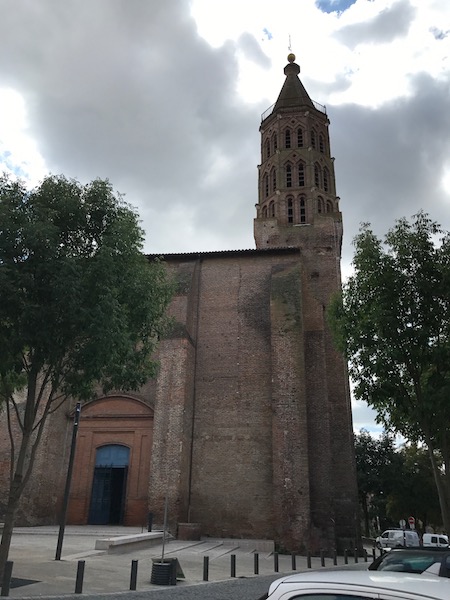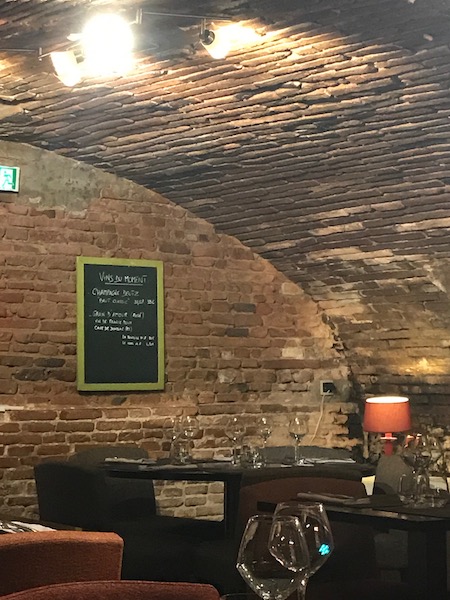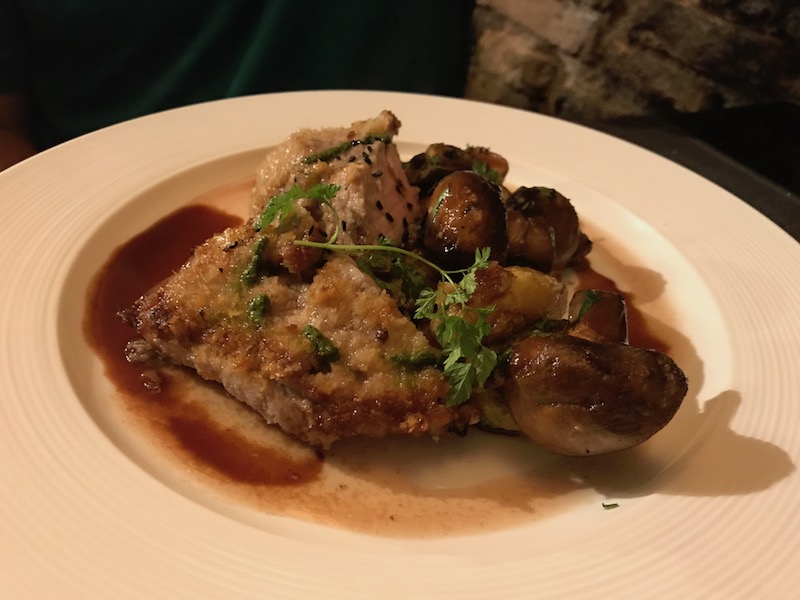Our Blog - Montauban, France
The city dates back to 1144, and depending on if you consider it a bastide or not, it "may" be the oldest bastide in Southern France. Trivia note: During World War II, Leonardo da Vinci's Mona Lisa was briefly hidden in a secret vault behind a wine cellar at Montauban.
We stayed at an older hotel, the L'Hotel du Commerce, right next to the Cathedral, which was nice. Parking was a little bit "iffy" although if we would have arrived a bit later in the afternoon, it would have been much easier. The building itself is a grand mansion from the 18th century.

Our first stop was the Tourist office, which is our "norm" now. Almost every town of any size has one, and we can get maps and information, many have self-guided walking tours. The tourist office in Montauban is housed in the former Jesuits college. The Jesuits came to the town in 1629 and by 1676, had purchased a townhouse and established their college and chapel (which is the right-hand size of this first picture ... you can see the oval stained glass windows on the middle floor, close-up in the last picture).



In 1777, the intendant settled permanently in this house, the Hotel Prat Dumiral. This was the royal civil servant sent by the king to an area to supervise and enforce the king's will in the areas of finances, policing, and justice. There were two main buildings with a courtyard and garden between. An additional wing was added in 1822 and then expanded during the Second Empire. This now is the Prefecture for the Tarn-et-Garonne department.



This is the Cathedral of Notre Dame, which was next to the hotel and we could see from our hotel room. It was built on the town's highest plateau and symbolized the absolute power of the Catholic royalty over the citizens of what was considered a rebellious town. It is the work of 3 different architects and was consecrated in 1739. It has a classical facade with 4 huge statues up over the main door with the columns. The King's coat of arms is carved on the pediment at the very top.


The statues that are outside today are replicas and the originals are inside. They date from the 17th century are were carved in limestone by a sculpture named Marc Arcis. They are of 4 apostles: Matthew (with the child), Mark (with the lion), Luke (with the bull), and John (with the eagle). The only one that really I could make out was Mark (the lion at his feet was pretty clear to me) ... and I have Tom in one of the pictures to show the scale of these statues.




The main interior of the church itself wasn't all that impressive, personally. All of the really interesting decor was in the side chapels, and there were lots of those (like 20 of them). Many contained small altars, paintings, and statues dating back to the 17th, 18th, and 19th centuries. The stalls of the choir date to the 18th century and the white Italian marble altar was from 1857.





One of the things that was interesting about this church for us was the use of trompe-l'oeils (literally, trick of the eye). In many cases, these walls were just square, flat walls painted to look like they had carved marble columns and domes.

The Grand Organ dates back to 1672 and was moved from the prior Cathedral, Saint-Jacques, to this Cathedral after it was built.

Probably the highlight of the Cathedral is the 1824 painting entitled 'Le Voeu de Louis XIII' (The Vow of Louis XIII) by Jean-Auguste-Dominique Ingres, a French neoclassical painter who was born in Montauban. Although he considered himself to be a painter of history, likening himself to Poussin or Jacques-Louis David, he is more known for his portraits than anything else. The subject is Louis XIII's vow, in 1638, to consecrate his kingdom to the Virgin in her assumption. The painting took 4 years to complete, which was done while Ingres was living in Florence.


This is an early 18th century town house, name the Hotel Mila de Cabarieu. It is named after the lieutenant in command of the provincial regiment of Montauban who owned the house in 1777. Through the gates and on the left side of the courtyard, you can see a portico with high arches and imposing brick columns, with a specifically Italian flair. Unfortunately, the gate is as far as we could go because it is not open to the public.



This huge mansion is now home to the town hall. There supposedly is a great staircase but we didn't go in since it seemed odd going into town hall. The buildings themselves aren't all that impressive, but the huge limestone gate was worth a look.



This is the Hotel de Monmilan, built in the first half of the 18th century. It has two interesting features. First, the monumental portal with 4 iconic columns, out of brick with the white limestone ionic column headers. It also includes a wrought iron tympanum with the intertwined initials of Andre Duval de Monmilan, who lived here in 1790. The second feature is the statue of a dog that sits within a niche that is visible from the gates. It is also not open to the public.




The church of Saint-Jacques is one of the 2 remaining medieval structures. It has several elements, all from different centuries. The belfry (in Toulouse-style) and part of the nave date to a 13th century church, the apse in the 14th century, and the neo-Romanesque facade portal with mosaic dates from the 19th century. The front still has scars from cannonball fire dating from the 1621 seige. The interior seemed much more vivid, although the paintings and frescos had not been restored. Around the altar, under a set of stained glass windows, were a set of paintings.











Place Nationale is the heart of the city now, just as it was when the medieval grid pattern plan for the city was laid out. Curved arches and galleries line all 4 sides, and on a couple of the keystones, you can still see the construction dates in the 1600's and 1700's. Two different fires in the 17th century took the square down to ruins and it was rebuilt. On one side was also a commemoration with the name "Place Royale" for the 800th anniversary of the founding of the city (1144 to 1944). Found it a little interesting that in the middle of World War II, they were commemorating an anniversary.








In the mid 18th century, Montauban got its first theater, but it was too small and was rebuilt in 1849. At that time, the Theatre Olympe de Gouges took inspiration from its Italian counterparts. The facade that we see now was added in the 1930's when the square in front was created. The 4 bas reliefs on the top represent Dance, Music, Poetry, and Comedy.


This courtyard is within what was the Navarre college, founded in 1579 by the future King Henry IV and his wife. It has a lovely old wood balcony that was visible. Nearby was the Hotel Lefranc de Pompignan, dating from the late 17th century, which has a very nice portal into the courtyard. It is named for Jean-Jacques Lefranc de Pompignan, who was born here in August 1709 and was a poet, magistrate, and member of the Academie Francaise.


Along the river, there were 3 convents created when religious peace was re-established in 1629. The former Capucine convent, with its' massive white buildings (you can still see the signs for the seminary and chapel) has been turned into a pricey hotel. The second, which is tan with red brick trim, was built by the Carmelites in 1642 and today houses government offices. The last one, all brick, was the Clarisse convent from 1631. Today it houses a retirement home.





Overlooking the water is this large brick building, which houses the Museum of Natural History. It is housed in a former palace whose facade was rebuilt in 1836 in a Neoclassical style that was all the rage at that point in time. You can also see in the last picture how high the original ramparts were.



Point Vieux, or the Old Bridge, was planned as part of the original 1144 charter, but was only built in the early 14th century after getting approval and support from King Philip IV the Fair. It is 205 meters long and when built, was exceptional in that the roadway was flat (very unique for that point in history). It has 7 arches and the pillars are pointed to enable the bridge to resist the floods of the Tarn river. We took multiple pictures of the bridge and river from various points. You can also see an island in the middle of the river ... this is the Ile de la Pissote, which is a natural reserve for nesting birds.











The New Bridge, Point Neuf, can be seen in these two pictures. It was opened in 1913 and was unique in its' design. At that time, metallic bridges were still what was normal. The civil engineer opted for a more modern design, using reinforced concrete.


This was across the parking lot/square from the hotel, and it is the facade of the former post office, with the 3 statues.

Dinner was an interesting find. It is right next door to the hotel and actually has a relationship with the hotel so that they have a special menu just for hotel guests. In TripAdvisor, it is actually rated as the #1 restaurant out of almost 200 in the city of Montauban. The street-level view is pretty bleek, but there is a wonderful brick vaulted basement which is where we dined (they did have a couple tables upstairs, but if you go, try to get downstairs).


The entree's that we selected included a marinated mackerel on a bed of tomatoes (perfect timing as they are in season right now) and a house-made tapenade on toast. The other was a cold pumpkin soup. Both were lovely and perfect starters heading into the main courses.


The main plats were a filet of Eglefin (that is a white fish) on a bed of celery root puree (very French) topped with raw celery root cut into matchsticks. I hadn't really done much celery root before but I actually now have a couple recipes with it and I like the root much more than I like the green tops :-). The other was a veal escalope with potatoes and mushrooms (which are just coming into season).


And the dessert ... a tiaramisu and a cheesecake with sorbet.

